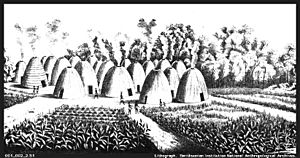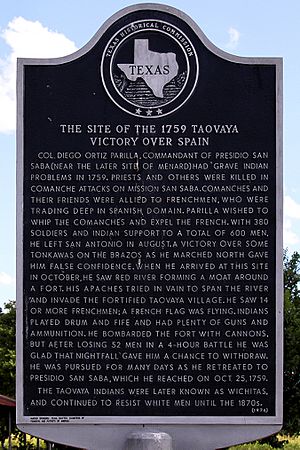Taovaya people facts for kids
| Total population | |
|---|---|
| fewer than 2,953 (2018) | |
| Regions with significant populations | |
historically |
|
| Languages | |
| English, Taovaya, Wichita | |
| Religion | |
| Native American Church, Christianity, Indigenous religion |
|
| Related ethnic groups | |
| Caddo, Pawnee, other Wichita and Affiliated Tribes |
The Taovaya were a Native American tribe. They were part of the larger Wichita people. The Taovaya originally lived in Kansas. Later, in the 1700s, they moved south into areas that are now Oklahoma and Texas.
They spoke a special kind of the Wichita language. This language belongs to the Caddoan language family. Today, descendants of the Taovaya are part of the Wichita and Affiliated Tribes. This is a tribe officially recognized by the government. Their main office is in Anadarko, Oklahoma.
Contents
Other Names for the Taovaya
The Taovaya tribe was known by many different names. People sometimes called them Aijado, Tahuayase, Taouaize, Tawehash, Teguayo, Toaya, or Towash.
Daily Life and Culture
The Taovaya shared many traditions and their language was very similar to other Wichita tribes. They were skilled farmers. They grew important crops like maize (corn), beans, melons, gourds, and tobacco.
They also hunted bison, which were large buffalo. The Taovaya lived in villages for most of the year. These were called semi-permanent settlements. But when they followed the bison herds for hunting, they lived in temporary camps.
Early Beginnings

The Taovaya are one of several Wichita tribes. Other groups include the Tawakoni, the Waco, and the Wichita Proper. The Taovaya first lived in Kansas, and maybe even southern Nebraska.
In 1541, a Spanish explorer named Francisco Vásquez de Coronado traveled across the Great Plains. He was looking for a rich land called Quivira. Instead, he found the ancestors of the Wichita people. They were many farmers and buffalo hunters in central Kansas. They did not have the gold or riches Coronado was looking for. The area he called "Tabas" was likely near Lindsborg, Kansas. This name sounds a lot like Taovaya.
From about 1630 to 1710, the Taovaya might have lived near what is now Marion, Kansas. Scientists have found old village sites there that match this time period.
Facing New Challenges (1700s)
In 1719, a French explorer named Claude Charles Du Tisne found two villages. He called the people "Paniouassa," which was a French term for both Pawnee and Wichita tribes. These villages were likely Taovaya, near modern-day Neodesha, Kansas. In the same year, another French explorer, Bernard de la Harpe, visited a village in Oklahoma. It had people from several Wichita tribes, including the "Toayas" or Taovayas. La Harpe said the Taovayas were the largest Wichita group.
By the 1700s, other tribes began to move into Wichita lands. The Osage came from the east, and the Apache from the west. This put a lot of pressure on the Wichita in their homes in Kansas and Oklahoma.
In the 1720s, the Taovaya and their relatives, the Guichita, started moving south. They settled along the Red River. They built a large village in Jefferson County, Oklahoma, on the north side. They also had a village on the south side, at Spanish Fort, Texas. By the late 1750s, many Wichita tribes lived in Texas or across the Red River in Oklahoma.
The Taovaya were friends with the French. In 1746, the French helped the Taovaya and other Wichita tribes make peace with the Comanche. The Taovaya became very powerful in the next few decades. Their village at Spanish Fort was a busy trading center. Comanches brought enslaved Apache people, horses, and mules. They traded them for French goods like powder, knives, and cloth. They also traded for crops grown by the Taovaya, such as corn, melons, and tobacco.
Battles and Alliances
Because they were allies with the French, the Taovaya often had problems with the Spanish. Spain had several forts and missions in southern Texas. In 1758, the Comanche, Taovaya, and other Wichita tribes destroyed the San Sabá de la Santa Cruz mission.
The next year, Spain sent a large army of 500 soldiers to attack the Taovaya village at Spanish Fort, Texas. But an army of Native Americans met the Spanish soldiers and defeated them. They even captured two cannons. About 50 Spanish soldiers were killed or hurt. This failed Spanish attack in 1759 is known as the Battle of the Twin Villages.
The Taovaya continued to fight against the Spanish and their allies, the Lipan Apache. But in the 1760s, they also acted peacefully towards Spanish missions among the Hasinai, a Caddo tribe. In 1764, a Taovaya leader named Eyasiquiche led an attack near Mission San Lorenzo de la Santa Cruz. They captured a Spanish soldier named Antonio Trevino. Eyasiquiche first planned to adopt Trevino into the Taovaya tribe. But when he learned Trevino was from Los Adaes, he decided to send him back.
The French lost their American lands in 1763 after the French and Indian War. This made it harder for the Taovaya to get French trade goods. So, they became more open to making peace with the Spanish. This took time because French traders stayed in Louisiana. It wasn't until Alejandro O'Reilly became governor that rules stopped French trading with the Taovaya.
In 1771, the Taovaya, other Wichita, and the Tonkawa made a peace agreement with the Spanish. This was against the wishes of the Comanche. The Taovaya's trading power lessened because of the Comanche and a sickness, probably smallpox. This sickness hit the Wichita in 1777 and 1778, killing over 300 people.
In 1778, the Taovaya village at Spanish Fort had 123 houses. Across the Red River, another Wichita town had 37 houses. Together, these two towns had about 600 men and a total population of around 2,500 people. However, this was much less than the tens of thousands of Wichita people during Coronado's time. In 1801, another sickness killed many more. In 1805, an American agent named Dr. John Sibley thought there were only about 400 Taovaya men left.
The 1800s and Beyond
The Taovaya tribe, as a separate group, ended quite suddenly. In 1811, their chief, Awahakei, died while visiting Americans in Natchitoches, Louisiana. The tribe did not choose another leader and split up. Some joined the Tawakoni tribe on the Brazos River. Americans then started calling all these groups "Wichita."
In 1835, the Taovaya signed a treaty with the Americans. They were moved from Texas to an Indian reservation in what was called Indian Territory (now part of Oklahoma).
Their Lasting Legacy

The place where the Taovaya defeated Spain in the Battle of the Twin Villages in 1759 has a historical marker. It was put there in 1976 to remember their victory.
The Taovayan Valley, a region between the Wichita Mountains and the Red River of the South, is named after the tribe. This area was their last main home before they were moved to Indian Territory.


